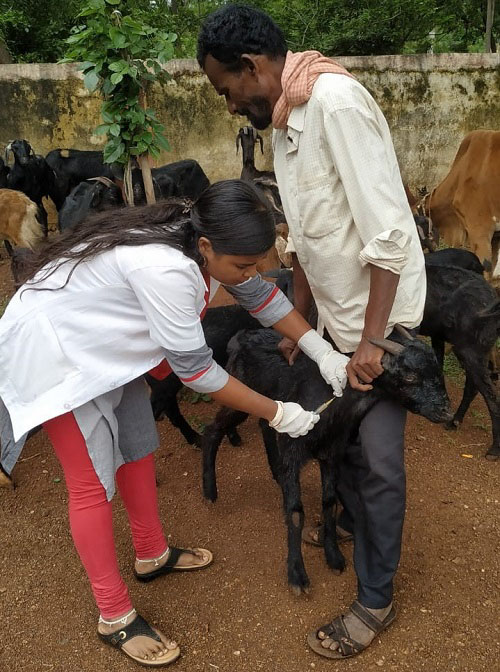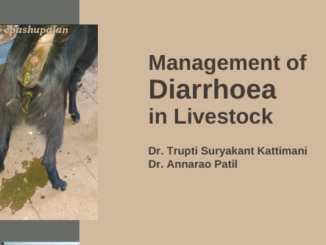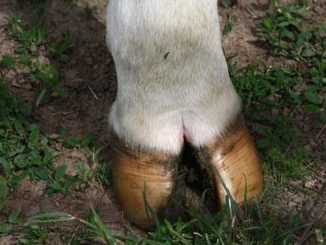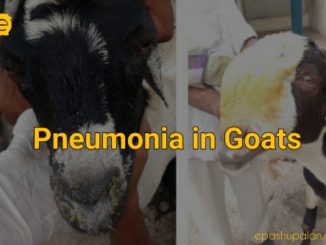Goat is the one of the early domesticated animal, earlier goat farming activity was limited to livelihood activity, now it became as a important commercial activity. According to 20th Livestock census report (2019) India has 148.88 Million of goats, so India having 2nd highest population in the world followed by China. Compared to previous livestock census report (2013) there is 10.1 % raise in the goat population in India, indicating steady growth in goat population and goat farming in India. Goats are capable of adjusting of wide range of climatic conditions, rearing can be done in famine, drought prone and drought areas. Goats will sustain and produce well under low fodder, low water and extreme adverse climates and it will produce well in terms of milk, meat, manure and hide.
Goat is versatile and multipurpose animal because it will adjust all type of climatic condition and produces variety of products like, meat, milk, kids, manure and hide. Goat is known as poor man’s cow because it will produce milk, meat and manure like cow at very low cost. Goats are docile, good tempered, co-operative animals easy to rear by women, land less labour and children and they will thrive well on shrubs, bushes and kitchen waste. They are known as moving ATM because they will provide financial assistance to farmer thought the year in all situations.
Advantages of goat farming
- Very low investment: In the cost of one pregnant buffalo we can get 10 pregnant goats.
- Less labour requirement: Under grazing system 30-40 goats and under stall feeding 40-80 goats can be reared by single person. Compared to other animal farming goat farming needs less labours.
- Chevon : Chevon having less fat compared to other meats, having protein with high biological value, don’t have any taboo and consumed by all community people. It has getting more demand day by day due to its high nutritional value and taste.
- Milk: Goat milk highly nutritious, having more solids, easily digestible and less allergic compared to other species. Goat milk also used in the preparation of ayurvedic medications and commercial preparations. Metro cities are the best place for the marketing of milk.
- Goat manure: Goat manure has 2.5 times more nitrogen and phosphorus compared to cattle and buffalo manure. So agriculture and horticulture farmers have more faith on goat manure.
- Multipurpose animal: Goat will produce milk, meat, skin, manure and kids.
- High prolificacy: Goat has extraordinary reproductive ability compared to other domestic animal species, yearly twice kidding and twin and triplets are common in goats.
- Easily marketable: Goat milk, meat, kid and manure having high demand in market.
- Easy to rear: They will not demand high profile nutrition, they will survive and reproduce with low quality feed and fodder.
- Goats are docile, good temperament, co-operative, easily manageable animals. So women can easily rear the goats.
Challenges in goat farming.
Challenges includes, highly unorganized & most of time monopoly marketing .Endemic disease problems, limited feed resource due to farmers are behind the commercial crop practice, due to urbanization and industrialization grazing land of goats depleting every year. Water problem due to low rain, climatic variations like famine, flood and lightning strike and labour shortage. Unavailability of high genetic potential breeds of goat, absence of high producing exotic cross breed, lack of scientific feeding practices and feeding management at farmer level. High kid mortality due to colibacillosis, starvation, extreme climatic condition, death of mother due to parasitic infestation as a result of poor management.
Challenges can be overcome by change in marketing strategy, growing of fodder crops and trees, conservation and harvesting of rain water, following of alert messages about climatic variations, practicing hygiene in the goat she and regular following of deworming, dipping for external parasites and vaccination schedule and good management practices in the farm will reduce the kid and adult mortality in the farm.
Tips for successful goat management
- Follow regular deworming and vaccination, don’t wait for diseases to come.
- For local market local breed goats are best.
- Start farming with the guidance of veterinarian.
- Don’t rear grazing goats in stall feeding farms and vice versa.
- Semi-intensive farming is the best method for the goat farming.
- Start farming with local breeds and create your own market channel for milk and meat, than upgrade your breeds in the farm.
- Regular hygiene and good management practices are very much essential for optimum production.
- Work in already running goat farms for a period of 15 days to one month before starting your goat farming unit.
- Visit nearby local livestock market and have an idea about goat demand, supply and market.
- Seasonal management is essential for better performance.
- Isolation and prompt treatment is very much essential for the control of disease.
- Cultivation of fodder and fodder plants are key to success in goat farming.
- Feeding of low amount of concentrates and high amount of roughages will be ideal for goat feeding.
- Provide regular clean and fresh drinking water and urea-molasses blocks licking will enhances the production of saliva and there by improves the digestion in goats.
- Foot baths and applying of lime powder in rainy season will reduce the foot rot incidence in the farm.
- Proper collection and sell of goat manure will increases the income in goat farming.
- Sale of goats in the high demand seasons like Bakrid, dasara and village festival will have more income compared to sale in lean season.
- Have affection and affinity towards animals.
- Regular animal health check up should be done for the control of diseases.
- Restrict unauthorized movement of animals and human in the goat farm.
Feeding of goats
In India goat farming done in extensive system that is following of grazing pattern. Here animal are allowed to graze on grazing land and pasture land. Main advantage of this system is zero cost on feed and cost of production will be very less. Semi-intensive system, here animals are grazed on land followed by feeding in the shed, Most of time concentrate feeding is practiced to get the desired body weight for the market. Stall feeding or Intensive system- here zero grazing is practiced and complete stall feeding pattern followed, but the cost on feed will increases leads to more cost of production and less margin to farmer. Goats are versatile eaters, natural browsers, weed destroyers .Dry matter requirement for goats is 6% BW which is highest among all domestic livestock species. Goats will feed on green fodders like all type of green grasses, legumes, tree leaves. Dry fodder like hay, straw, roughages and crop bi-products are efficiently utilized by goats. Conserved fodder like silage and hay will be best fodder for goats. Concentrates about 50gm-300gms can be fed to goats. Concentrate feeding will predispose conditions like lactic acidosis and enterotoxaemia disease. Regular clean and potable drinking water should be provided. Mineral mixture feeding will improves health status and feeding of urea-molasses blocks will increases salivation and digestion of fibres.
Marketing of goat
Marketing is Challenging task in goat farming. Most of time farmer and butcher will get same margin .Farmers face monopoly system due to butchers are the only buyers. For better returns and profit sell goat milk and meat directly to consumers. Selling to new farming units or new farmers who are starting goat farming will have good margin. Don’t farm high profile breeds for local butchers because they will purchase at low rate leads to loss and high profile breeds needs more care and feed input leading to increased cost of production. Start farming with local breeds updates the market and once you get good market than update your breed in the farm. Create a market channel in cities for milk and meat. Sell the goats during peak demand situations like Bakrid, Dasara, village festival seasons where there is huge demand for goats especially male goats. Recently male kid rearing in goat becoming popular due to Short period of rearing of male kids having more demand and farmers will get more margin in terms of rupees. Milk-more demand in cities-100 ml, 200 ml, 500 ml. Make an agreement with corporate companies for the sale of milk and meat in cities for competitive price.
Helath challenges includes
Diarrhoa (Scours)
Increased frequency, fluidity, or volume of fecal out put.
Etiology: bacterial, viral, parasites, diet, and stress. In younger kids – Rota virus, E. coli, Salmonella causes diarrhoea. In older kids coccidia is common cause of diarrhea causes blood mixed diarrhea called as dysentry. In adults diarrhea is symptom of other illness. E.g. Gastro-intestinal parasites, acidosis, enterotoxaemia, John’s disease, and plant toxins. Treatment depends upon cause: anti-diarrheal medications, anti-coccidial medications, antibiotics, anthelmintics, probiotics, fluid and electrolytes.
Respiratory infection in goats
It has multiple etiology factors, namely viruses such as PPR virus, Para influenza virus 3, Adeno virus, Respiratory syncital virus. This viral infection complicated by bacterias including Pasteurella multocida, P haemolytica, Klebsiella pneumoniae, E. coli, Staphylococcus aureus, Corynebacterium pyogenes, Mycobacterium bovis. Mycoplasma.
Symptoms includes pyrexia, anorexia, sneezing, coughing, nasal discharge, dyspnoea, bilateral mucopurulant discharge, weakness, congested mucus membrane not responding to routine treatment.
Treatment
- Broad spectrum antibiotic therapy should be given.
- Symptomatic therapy including bronchodilators-Theophylline, Aminophylline as per prescribed dosage and nebulization with mucolytic agents like N acetyl cystine should be done ( 10-20%).
- Homeopathic medicine : Anti-viral drug Viroline syrup-1ml/animal PO should be given.
Anaemia
Most neglected condition.Associated with multiple etiological conditions. Caused by external Parasites namely tick, lice, fleas. Internal parasites namely nematodes-Strongyles, tape worms-Monizia spp. Nutritional deficiency due to Soil and fodder deficient in Fe & Cu. Enteric protozoa namely Coccidiosis is primary cause in young animals. Haemoprotozoal infection such as Thileriosis, Babesiosis and Anaplasmosis will also causes anaemia in goats. Symptoms of anaemia are pale to paper white mucus membrane, dull, depressed, anorexia, lethargy, dyspnoea, sub normal temperature, hurried respiration, exercise intolerance, tachycardia, rough hair coat, jugular pulsation, geophagia and partial to complete anorexia. Pale to paper white buccal mucosa, retarded growth in kids.
Tetanus
Caused by- Clostridium tetani, predisposing factors are prolapse, dystocia, wound, foot rot, improperly treated abscess. Symptoms include pyrexia, anorexia, dullness, depression, muscle stiffness, extension of head and neck, lock jaw and death. Treatment- 1)ATS-Anti Tetanus Serum. 2)Penicillin- 20,000-40,000 IU/kg BW Prevention 1) Tetanus Toxoid inj 2) Wound management.
Foot rot
Caused by- bacteria namely Bacteriodes nodosus, Fusobacterium necrophorum and other opportunistic bacterias. Condition common in season July-Sept. Symptoms are wound in interdigital space with pus and lameness, anorexia, pyrexia, rough hair coat, stunted growth, abortion in female and fall in milk yield in female animals. Symptomatic Treatment should be given. Foot bath from Formaldihyde, lime application on floor of shed, farm hygiene and avoid grazing in wet land.
Lactic acidosis
Causes- Accidental ingestion of high amount of grains, flour, concentrate mixture, feeding of high quality silage. Symptoms including Bilateral distension of abdomen, absence of rumination, discomfort, teeth granting, colic, diarrhea and death are observed. Treatment- 1) Symptomatic treatment 2) Sodium bicarbonate 3) Rumen Buffers given to change the PH of rumen.
Polioencephalomalacia
Common in kids caused due to deficiency of Vitamin B1 (Thiamine). Kids are more susceptible. Symptoms are star gazing posture, blindness, circling movement, head pressing. nervous signs. Treatment- high dose of Thiamine supplementation. B complex preparations(oral).B-Plex Forte Injection at prescribed dosage.
Mastitis
Multiple etiological agents will cause the disease. Kid bite , viral infections, physical trauma and injury will predisposes the disease later bacteria will complicate the condition. Its costly disease due to discard of milk and more treatment expenses..Incidence more in high milk producing breeds. Condition is also known as blue bag in ewes. Early diagnosis and treatment will helps in recovery. Late presentation often causes ineffective treatment leads to permanent damage of udder.
Osmanabadi breed of goat farming in Kalaburagi and Bidar districts.
Distribution- Osmanabad, Latur, Ahmadnagar, Parbhani, Solapur of Maharashtra and Bidar and Kalaburagi of Karnataka. The breed is famous for the adoption in wide variety of climatic conditions especially in very hot, sunny and drought prone climatic conditions. Breed has high prolificacy in reproduction and famous for the production of twins and triplets. Osmanabadi breed goats are known for the disease resistance compared to other breeds and are sturdy. It is the excellent breed for the extensive and semi-intensive type of rearing. Kidding is yearly twice. Female kids will becomes sexually mature at the age of 12-14 months, male kids will have market age at 12-14months. Adult male – 40-50 kg. Female -30-40 kg. Black coloured, white spots.Short hair coat, shinning face.Male are horned. 5% female polled.Milk yield – 1-1.5 litres/day.Dressing %- 50-60%.Age at first kidding- 12-14 months. It is the official recommended breed for the upgradation of local and non-descript breed goat of Kalaburagi and Bidar district from Govt of Karnataka under breeding policy. Most of farmers and entrepreneurs are rearing Osmanabadi goats in Kalaburagi and Bidar district and they are getting good returns/income from this breed of goats. This breed has good adaptation in this region and it has good disease resistance.

Vaccine schedule for Goats.
|
S.N. |
Name of the Vaccine | Age of the animal at the first time of vaccination | Type of vaccine |
Dose |
Route |
Duration of immunity |
| 1 | Enterotoxaemia ET Vaccine | After 4 months of age | Killed | 1ml | SC | Biannual in endemic area. |
| 2 | Black quarter BQ Vaccine | After 6 months of age | Killed | 2.5ml | SC | Annually in endemic area. |
| 3 | Hemorrhagic Septicemia HS | After 6 months of age | Killed | 2.5ml | SC | Annually in endemic area. |
| 4 | Foot and mouth disease FMD Vaccine | After 6 months of age | Inactivated cell culture
|
1ml | IM | Every six month. |
| 5 | PPR
Live attenuated |
After 3 months of age | Live | 1ml | SC | Annually in endemic area. |
| 6 | Anthrax Stern’s spore vaccine | 3 months and above | Live | 0.2ml | SC | Annually in endemic area. |
| 7 | Goat pox Uttarkashi strain goat pox vaccine | After 6 months of age | Live
|
1ml | SC | Annually in endemic area. |
| 8
|
Rabies (Pre bite) | 3 months and above
|
Killed | 1ml | IM | Annually in endemic area. Post bite vaccination schedule 0,3,7,14,28 and 90 days |
Deworming schedule for Goats
Deworming should be done in goats for the period of 3-4 months. Before deworming veterinarian advice is must and before deworming random faecal examination will gives the indication of type of parasites in that particular farm or village or idea. Dosage should be followed as per manufacturer instruction or veterinarian advice and care should be taken in physiological conditions like pregnancy and lactation. After deworming withdrawal period for milk and meat should be followed strictly.

References
- Livestock Census Report Govt Of India 2019.
- Handbook of Animal Husbandry G C Banarjee.







VERY GOOD INFORMATION ON GOAT FARMING.
Very informative and practical article